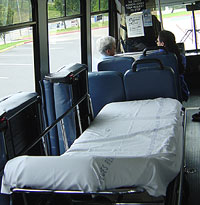Giving Emergency Room Physicians
|
"What if we could remotely 'see and hear' what the paramedic does in an ambulance while a patient is being transported to the hospital?" imagines Dr. Jim Killeen, an emergency room physician at UCSD's Thornton Hospital. "Then we could be more prepared with appropriate personnel and equipment when the patient arrives. And the better prepared we are, the better the outcome is likely to be."
What Killeen is suggesting - and what he and colleagues have already tested - is an early incarnation of a "cyber ambulance": an ambulance equipped with wireless telecommunications technology to enable transmission of audio, video, and numeric information (e.g., an lectrocardiogram) of a patient's condition en route to the hospital.
This experiment leveraged technology developed for a previous demonstration of mobile Internet access at high speed in UCSD's "CyberShuttle." The CyberShuttle integrates local-area 802.11b wireless technology with QUALCOMM's 1xEV-DO wide-area network technology that uses cell sites on top of Engineering Building Unit 1 at UCSD and at QUALCOMM headquarters in Sorrento Valley north of UCSD's campus.
This experiment formed part of a larger Calit² research activity, led by Dr. Leslie Lenert of the VA Hospital, focusing on prototyping a wireless information system for medical response in large-scale disasters. In such a scenario, the numbers and trauma of the injured are projected to be so significant that the injured need to be categorized for treatment and treated at the disaster site.
"We used a virtual private network as a straightforward means to overcome technical obstacles associated with using 'commercial off-the-shelf' components in the context of the network topology imposed by the QUALCOMM setup we used in the CyberShuttle demonstration," says David Hutches, technical overseer of both the shuttle and ambulance projects. "We used an encrypted channel to ensure patient confidentiality, as required by the medical application. While this caused a bit of a 'performance hit' - an expected cost of any encryption scheme - we found it did support a useful, real-world test for the medical community. We would expect to improve performance significantly by tuning a number of components on the link between the ambulance and the ER."
Two days before the experiment itself, Hutches and colleagues did bandwidth testing in the field, experimenting with different video frame sizes and rates of transmission to optimize them for the connection speed. "This work," volunteers Hutches, "is a good example of the difference Calit² makes: The CyberShuttle experiment generated a great deal of publicity, which, in turn, clearly got people thinking about how to extend the technology to their own favorite applications. This is just one of several we've worked on."
During the experiment, four "actor-patients," professionally trained to act in medical triage simulations, simulated symptoms related to common traumas: a gun shot wound, a stroke, a heart attack, and congestive heart failure. Emergency physicians, working remotely from the emergency room, supervised the paramedic on board the ambulance in each case, and a medical sociologist observed the overall experiment and provided an evaluation.
In general, the rates of video and data transmission were acceptable with occasional delays and a few "dead areas" in cellular coverage. However, the delay in audio was unacceptably long, causing the paramedic and physician to "talk past each other" confusing the communication, so a second cellular connection was used in place of voice-over-IP.
Physicians were able to direct the paramedic and correctly diagnosed the simulated condition in all cases. In general, they found the technology easy to use and believed it improved communication and resulting interaction with the paramedic.
Dr. Marisa Smith, the medical sociologist on the team, says, "We learned that different technologies and types of data can be more or less useful," she says, "depending on the nature of the patient's trauma. For example, the video image was more useful in the stroke scenario by comparison with the gun shot wound. That's because a correct diagnosis of a stroke requires a physical to determine if paralysis is only on one side, and facial muscles tend to be particularly telling."
The group also discovered tradeoffs in image size vs. resolution: Smaller images, say two inches square with higher resolution, seemed to provide more useful information than larger, more blurry images.
According to Dr. Ted Chan, a colleague of Killeen's in the emergency room, who also participated in the test, "We think this technology might particularly benefit paramedics in rural areas where ambulance rides tend to be longer or emergency medical technicians who have less training because it will allow the emergency room physician to guide ambulance care based on fuller information than has traditionally been available."
Smith takes that point one step further: "But we also wondered what the paramedic would 'make' of this technology. They're normally used to a significant degree of independence, but this technology might make them feel 'monitored' and, in some cases, resentful of the physician's perceived intrusion." Put another way, if paramedics feel like they are serving as the physicians' "virtual hands," how will they react to their compromised autonomy?
"I have to say," smiles Lenert anticipating a pun, "this experiment was the perfect 'vehicle' for getting our team to begin working together. And because this team is so wide-ranging -- spanning science, engineering, social science, and even the humanities with the actors involved -- we've started, in true Calit² fashion, by learning each others cultures and vocabularies."
This experiment was posed to determine whether this combination of technologies could provide sufficient bandwidth to enhance a patient's care before arriving at the emergency room. It answered some questions and clearly raised a host of others to motivate follow-on research.
The question potential patients will have is how such technology implementations might fundamentally change the balance between pre-hospital and hospital care, that is, what emergency medical procedures can and should be performed outside of the hospital, by whom, and aided by what technology?
Related Links
QUALCOMM
Related Articles
Calit2 Project Showcases High-speed Mobile Web Access


